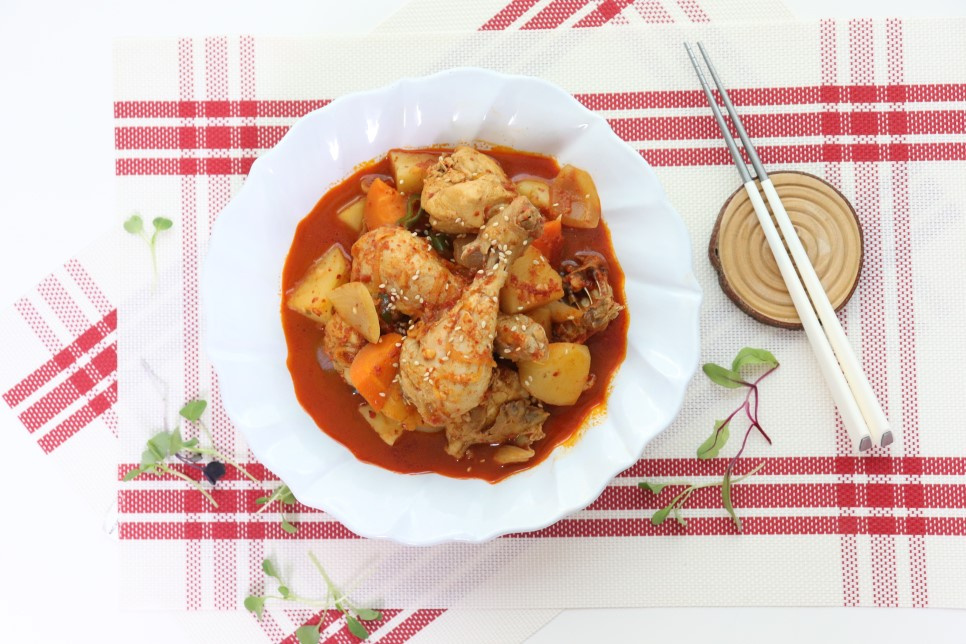Spicy and Refreshing Dakbokkeumtang (Korean Braised Chicken Stew)
How to Make Dakbokkeumtang Without Gamey Smell: Spicy, Savory, and Clean Flavor

Craving something spicy lately? I can’t eat a meal without some chili peppers these days! I found chicken on sale at the mart and quickly grabbed a whole one. While I usually make Samgyetang or soy-sauce based Dakbokkeumtang for the kids, this time, I made a spicy and robust #Dakbokkeumtang to suit my husband’s and my taste. This recipe focuses on a clean, non-gamey flavor and a deep, savory broth.
Main Ingredients- 1 whole chicken for Dakbokkeumtang (approx. 750g)
- 2 medium potatoes
- 1/2 carrot
- 1 medium onion
- 1 stalk green onion
- 3 cheongyang peppers (adjust to your spice preference)
- Sesame oil
For Chicken Preparation & Searing- Cold water (for washing chicken)
- Sesame oil (enough to coat the pan twice)
- Cold water (for washing chicken)
- Sesame oil (enough to coat the pan twice)
Cooking Instructions
Step 1
The chicken for today’s dish is about 750g, specifically prepared for Dakbokkeumtang. If you like a sweeter stew, adding an extra onion would be great.

Step 2
Here are the fresh chicken pieces for Dakbokkeumtang and all the ingredients we’ll be using today!

Step 3
Let’s start with the first step to a delicious Dakbokkeumtang: preparing the chicken.

Step 4
The chicken is already cut into bite-sized pieces. Rinse the chicken under cold running water 2-3 times to remove any impurities and excess fat.

Step 5
Thoroughly wash the chicken, especially the inside of the cavities, to remove any remaining blood or fat. This is crucial for eliminating any gamey odor from the chicken.

Step 6
Also, trim away any excess skin or fat from the chicken pieces. This will result in a cleaner, less oily stew.

Step 7
Place the cleaned chicken in a colander to drain thoroughly. This step helps prevent oil splattering when searing and further reduces any poultry smell.

Step 8
Traditionally, I would blanch the chicken. However, after watching Chef Lim Sung-geun on the TV show ‘Alto-ran’, I learned that searing the chicken in sesame oil effectively removes the gamey smell. I’ll be using this method today.

Step 9
Add the drained chicken pieces to a preheated pan.

Step 10
Drizzle about two swirls of sesame oil around the edges of the pan. The sesame oil will help tenderize the chicken and add a nutty aroma.

Step 11
Turn the heat to high and stir-fry the chicken. Sear it until it turns golden brown and some of its fat renders out.

Step 12
Continue to sear the chicken until the surfaces are nicely browned. This process locks in the juices and releases unwanted fats.

Step 13
Transfer the seared chicken to a colander to drain off any excess oil. This step ensures a cleaner and less greasy Dakbokkeumtang.

Step 14
While the chicken is being prepared, let’s make the seasoning sauce for our Dakbokkeumtang.

Step 15
In a bowl, combine 5 Tbsp soy sauce, 1 Tbsp minced garlic, 2 Tbsp cooking wine, 1 Tbsp sugar, 4 Tbsp gochugaru, a pinch of ginger powder, and a pinch of black pepper. Mix well to create the seasoning paste. Feel free to adjust the amount of gochugaru to your liking.

Step 16
Return the seared chicken (after draining oil) to a cooking pot. This allows the flavors from searing to infuse into the stew.

Step 17
Pour in 4 cups of rice water. Using rice water makes the broth richer and smoother, but regular water or stock can be used if rice water is unavailable.

Step 18
Add the prepared seasoning sauce to the pot and mix it well with the chicken. Ensure the sauce coats the chicken evenly.

Step 19
Bring the pot to a boil over high heat until the Dakbokkeumtang is vigorously bubbling.

Step 20
Once the Dakbokkeumtang comes to a rolling boil, it’s time to add the vegetables.

Step 21
First, add the potatoes and carrots, cut into large pieces. These vegetables will cook with the chicken and contribute to the delicious broth.

Step 22
When the potatoes are almost tender, add the chopped onion. The onion adds sweetness and depth, balancing the overall flavor profile.

Step 23
Finally, add the diagonally sliced green onions and the cheongyang peppers. Reduce the heat to low and let it simmer gently until the stew reaches your desired consistency. I left a bit more broth because I enjoy mixing it with rice.

Step 24
Enjoy this Dakbokkeumtang, which is clean and spicy without the heaviness of gochujang! My gochugaru is quite spicy as it’s made from Cheongyang chili peppers, but if you’re using regular gochugaru, consider adding extra cheongyang peppers for more heat. Enjoy your meal!



